
|
||||||||||
|
||||||||||
| Favorite Tweets by @thaibirding | ||||||||||
|
||||||||||
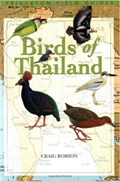 Buy Birds of Thailand on Amazon.co.uk |
||||||||||
| Site Map ; Contributors |
| Addition
of Kamchatka Leaf Warbler Phylloscopus examinandus and Sakhalin
Leaf Warbler P. borealoides to Thailand's Avifauna By Philip D. Round, Andrew J. Pierce, Takema Saitoh & Yoshimitsu Shigeta |
| Tweet |
| Note:
This article was originally published in Bulletin of the Japanese
Bird Banding Association 28 (2016) and was kindly submitted by
Philip D. Round. Please support the JBBA's work by visiting the JBBA website and becoming a member. |
| ABSTRACT The non-breeding season distributions of some Phylloscopus warblers are poorly known due partly to the difficulties of field identification. We document the addition of Kamchatka Leaf Warbler Phylloscopus examinandus and Sakhalin Leaf Warbler P. borealoides to the avifauna of Thailand based on five individuals and 12 individuals respectively. All P. examinandus were caught and banded on spring (northwards) migration, while the P. borealoides sample included both autumn and spring birds. Their identity was established through assay of the cytochrome c oxidase subunit I (COI) gene (c. 700 bp) of the mitochondrial genome. We present biometric data for these birds together with representative samples from the respective sibling species, Arctic Warbler P. borealis and Pale-legged Leaf Warbler P. tenellipes. We suggest that both P. examinandus and P. borealoides winter mainly or predominantly in the Sunda Subregion. |
INTRODUCTION |
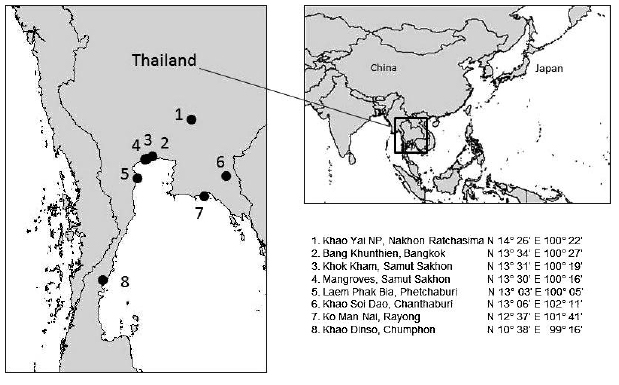 Fig. 1. Map of Thailand to show capture locations mentioned in the text. |
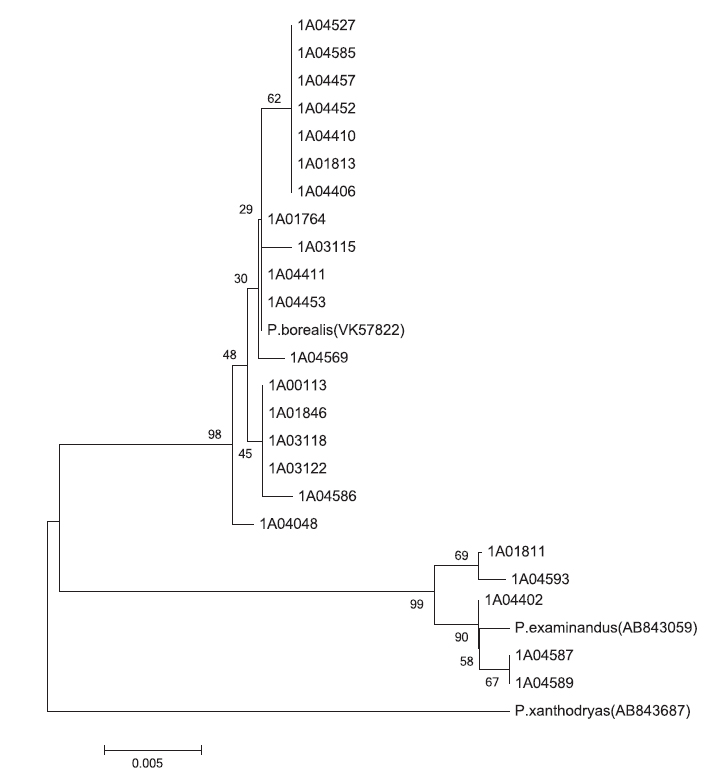 Fig. 2. Neighbour-joining trees of partial COI sequences from "Arctic Warblers". The tree was rooted using Japanese Leaf Warbler P. xanthodryas as outgroup (DNA accession number AB843687). Numbers at each node indicate bootstrap support (K2Pmodel, 1,000 replicates). |
| Sakhalin
Leaf Warbler P. borealoides A total of 24 "Pale-legged Leaf Warblers" were sampled of which we were able to determine the DNA sequences of 21 individuals, sampling 602 to 691 bp in the COI region (Japan DNA Data Bank accession Nos. LC087184 – 85; LC087189, LC87194, LC87203-08; LC87210-12; LC87219-25; Appendix 1, Fig. 3 ). Nine belonged in the P. tenellipes clade, and 12 in the P. borealoides clade (Fig. 3 ). No result could be obtained for three other birds for which no usable DNA was extracted. |
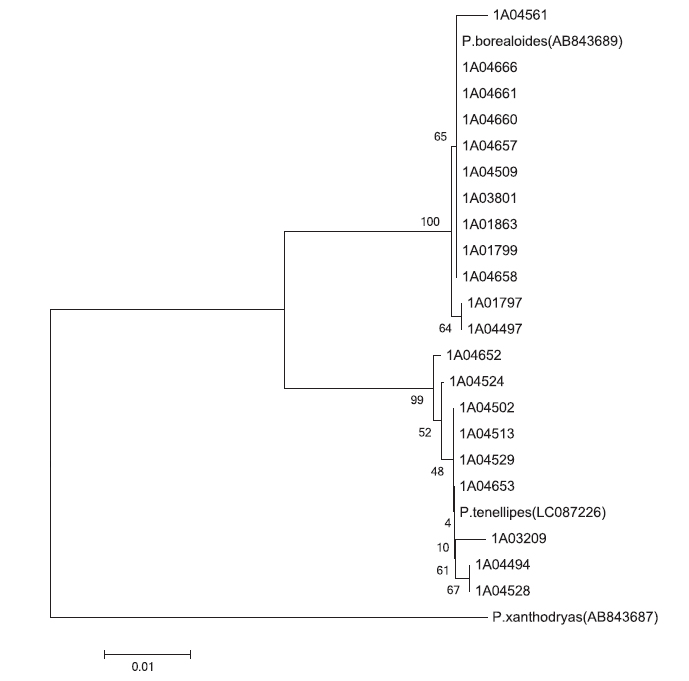 Fig. 3. Neighbour-joining trees of partial COI sequences from "Pale-legged Leaf Warblers". The tree was rooted using Japanese Leaf Warbler P. xanthodryas as outgroup (DNA accession number AB843687). Numbers at each node indicate bootstrap support (K2Pmodel, 1000 replicates). |
Table
1. Summary of biometrics (mm) of trapped Phylloscopus
sampled for DNA. Bill width measured proximally (base of the nares) and bill depth distally (distal edge of the nares). P1 (Outermost primary) was measured as projection beyond the longest primary covert. |
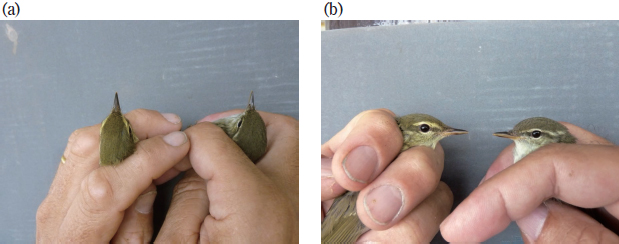
Fig. 4. A Kamchatka Leaf Warbler Phylloscopus examinandus (band no. 1A04402) alongside an Arctic Leaf Warbler P. borealis (1A04401) showing the brighter green upperparts and more strongly yellow-tinged supercilium and underparts of the left individual. (a) Dorsal view; (b) lateral view. |
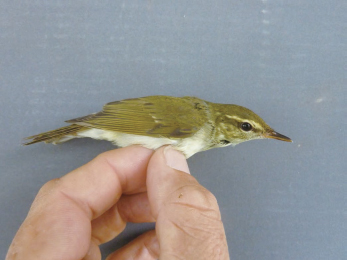 Fig. 5. Kamchatka Leaf Warbler Phylloscopus examinandus (band no. 1A04402) lateral view. |
| The P. borealoides were caught as presumed passage migrants, all but two during presumed southward passage, 2 Oct. to 2 Nov., from four localities. Three of the localities (Khok Kham, Samut Sakhon Mangrove Research Station and Laem Phak Bia, all on the shores of the Gulf of Thailand), were mangrove-dominated and the fourth, Khao Dinso, Chumphon Province, Peninsular Thailand was scrub and secondary forest on a 300 m elevation mountain, 1.5 km from the coast (Fig. 1 ). One of the two spring birds was caught in mangroves at Laem Phak Bia (on 19 Mar.) and the other on a forested island, Ko Man Nai, on 13 Apr. (Fig. 1, Appendix 1 ). |
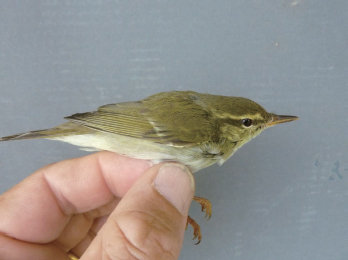 Fig. 6. Unusually bright Arctic Leaf Warbler P. borealis, band no, 1A04410, apparently identical in colouration to previous (P. examinandus) individual. |
| The
nine undoubted P. tenellipes included five birds that were
presumed southwards passage migrants caught during 5 – 20 October
from two of the same localities reported for P. borealoides:
Khao Dinso (four) and from mangroves at Khok Kham (one). Four further
P. tenellipes were caught from inland forest sites in eastern
Thailand: three midwinter birds from Khao Soi Dao Wildlife Sanctuary
and one bird in mid-April at Khao Yai National Park. It was unfor
tunate that this latter bird (band no. 1A03209; Appendix 1 ) was the
only one of four putative P. tenellipes caught at Khao Yai
(where the species has long been considered to be a common winter
visitor; Lekagul & Round 1991) to give an adequate DNA signature.
Even so, while the result was sufficient to identify it unequivocally
as a P. tenellipes, the full sequence was not registered
with DDBJ as many unreadable sections were interspersed within. The two species are very hard to distinguish, with similar plumage, and a large overlap in wing measurements and wing formulae (Table 1 ). While P. borealoides is longer-winged than P. tenellipes, most birds caught lay in an overlap zone which presumably encompasses longer-winged (male) P. tenellipes and shorter-winged (female) borealoides. The longest-winged P. tenellipes caught in the present sample had a wing-length of 65 mm (Table 1, Appendix 1 ). DISCUSSION We have provided details for five records of Kamchatka Leaf Warblers P. examinandus and twelve records of Sakhalin Leaf Warblers P. borealoides in Thailand established through assay of the cytochrome c oxidase subunit I (COI) gene (c. 700 bp) of the mitochondrial genome. We present supporting biometric data for our small samples of both the former species compared with Arctic Warblers P. borealis and Pale-legged Leaf Warblers P. tenellipes (Table 1, Appendix 1 ). Distinguishing morphologically between P. examinandus and P. borealis, and P. borealoides and P. tenellipes are among the most difficult tasks facing the bird bander in the field. Where canonical discriminant analysis has been used successfully, for example to distinguish between borealis and examinandus (Saitoh et al. 2008, Saitoh et al. 2014), it is best applied to sexed specimens. When larger, longer-winged males and smaller, shorter-winged females are combined in an unsexed sample, as with livetrapped birds, this technique may be less reliable in separating between all the members of either species pair. Our results concerning the separation of P. tenellipes from P. borealoides would suggest that any individuals with wing lengths longer than 65 mm might reasonably be identifiable as P. borealoides. However Bozó & Heim (2015) apparently recorded P. tenellipes with a wing length up to 67.5 mm from a sample of 79 individuals trapped and ringed during autumn passage in the Amur region. Our birds were mostly caught as passage migrants at coastal sites. It is important to resolve the wintering ranges of the taxa through increased mist-netting and sampling during the midwinter period at a wide range of inland forest locations in Thailand and elsewhere in SE Asia. We consider, based on the location and late timing of the spring passage captures of P. examinandus, that its wintering range most likely lies in peninsular Thailand or further south within in the Sunda subregion (perhaps Malaysia or Sumatra). Supporting evidence for a Sundaic wintering area in P. examinandus comes from long winged "Arctic Warblers" (wings > 71– 73 mm), both specimens and banded birds, captured at localities. further south in peninsular Thailand and Malaysia on likely spring (21 Apr. – 30 May) and autumn (24 Sept.) passage dates (Medway & Wells 1976, Wells 2007). Dates of all P. borealoides so far identified in Thailand are likewise concordant with migration to a wintering area south of the capture localities, in the Sunda subregion. Additionally, an over-wintering P. borealoides was documented in Singapore (Yap et al. 2014). The midwinter capture dates of three P. tenellipes in Eastern Thailand, on the other hand, together with three further relatively short-winged (59– 63 mm) individuals from which DNA could not be obtained (Appendix 1 ), but which were likewise almost certainly P. tenellipes rather than P. borealoides, suggests that the former species may winter predominantly in that region (where borealoides has not yet been recorded). Since P. tenellipes were also captured on migration alongside P. borealoides in peninsular Thailand, this indicates that its full wintering range certainly extends to the peninsula or elsewhere in the Sunda subregion. Similarly, given our limited sampling, the possibility that some P. borealoides may also winter as yet undetected alongside P. tenellipes in eastern or central Thailand cannot yet be ruled out. Increased sampling of migrants may also resolve the differences in timing of passage between P. examinandus and P. borealis on the one hand, and P. borealoides and P. tenellipes on the other. Larger samples of the latter species-pair, particularly if both wing-formula and vocalizations are recorded, may yield more reliable methods of distinguishing them since the call of P. tenellipes is markedly higher in frequency than that of P. borealoides (Weprincew et al. 1989, Yap et al. 2014). P. examinandus is also distinguishable on call from P. borealis (Alström et al. 2011). ACKNOWLEDGEMENTS We are grateful to the Department of National Parks, Wildlife and Plants Conservation (Thailand) for access to bird bands and for permission to band birds in protected areas. We also thank the Laem Phak Bia Environmental Research and Development Project, and the Department of Marine and Coastal Resources (Thailand) for permission to operate at sites they administer. Wichyanan Limparungpatthanakij, Sontaya Manawattana, Jonathan Murray, and Dr. Wangworn Sankamethawee provided assistance in the field. Philip Round is supported by The Wetland Trust. |
| REFERENCES Alström, P., Saitoh, T., Williams, D., Nishiumi, I., Shigeta, Y., Ueda, K., Irestedt, M., Bjorklund, M. & Olsson, U. (2011) The Arctic Warbler Phylloscopus borealis—three anciently separated cryptic species revealed. Ibis 153: 395–410. Bozó, L. & Heim, W. (2015). Trapping and ringing Pale-legged Leaf Warbler Phylloscopus tenellipes, Muraviovka Park, Amur region, Far East Russia. BirdingASIA 23: 118 – 120. Deignan, H. G. (1963). Checklist of the birds of Thailand. US Nat. Mus. Bulletin 226. Smithsonian Institution, Washington, D. C. Dickinson, E. C. & Christidis, L., eds. (2014) The Howard and Moore complete checklist of the birds of the world, 2. Fourth edition. Eastbourne UK: Aves Press. Hebert, P. D. N., Ratnasingham, S. & de Waard, J. R. (2003). Barcoding animal life: cytochrome c oxidase subunit 1 divergences among closely related species. Proceedings of the Royal Society B: Biological Sciences 270: 596 – 599. Lekagul, B. & Round, P. D. (1991). Guide to the Birds of Thailand. Saha Karn Bhaet, Bangkok. Medway, L. & Wells, D. R. (1976). The Birds of the Malay Peninsula. Vol. 5. H. F & G. Witherby and Penerbit Universiti Malaya, London and Kuala Lumpur. Portenko, L. A. (1950). [Kunashir Island] Reports of Academy of Sciences of USSR, new series, 20, No. 2. (In Russian). Phylloscopus borealoides Portenko 1950 DokladyAkad.NaukSSSR.n.s 70: 319 – 322. Round, P. D., Pierce, A. J., Nualsri, C. & Sankamethawee, W. (2015). A record of Japanese Leaf Warbler Phylloscopus xanthodryas in Thailand. BirdingASIA 23: 133 – 134. Saitoh, T., Nishiumi, I., Alström, P., Olsson, U. & Ueda, K. (2006) Deep phylogeographical divergences among far eastern populations of the widespread Arctic Warbler. J. Orn. 147: 242. Saitoh, T., Shigeta, Y. & Ueda, K. (2008) Morphological differences among populations of the Arctic Warbler with some intraspecific taxonomic notes. Orn. Sci. 7: 135–142. Saitoh, T., Alström, P., Nishiumi, I., Shigeta, Y., Williams, D., Olsson, U. & Ueda, K. (2010) Old divergences in a boreal bird supports long-term survival through the Ice Ages. BMC Evol. Biol.10: 35 doi:10.1186/1471- 2148-10-35 (available at http://www.biomedcentral.com/1471– 2148/10/35). Saitoh, T., Shigeta, Y. & Ueda, K. (2014). Species identification to the three allospecies of Phylloscopus [borealis] superspecies based on morphology. The Bulletin of the Japanese Bird Banding Association 26: 45 – 61. Saitoh, T., Sugita, N., Someya, S., Iwami, Y., Kobayashi. S., Kamigaichi, H., Higuchi, A., Asai, S., Yamamoto, Y. & Nishiumi, I. (2015). DNA barcoding reveals 24 distinct lineages as cryptic bird species candidates in and around the Japanese Archipelago. Molecular Ecology Resources 15: 177 – 18. Svensson, L. (1992). Identification Guide to European Passerines, 4th Edition. Published by the Author, Stockholm. Tamura, K., Peterson, D., Peterson, N., Stecher, G., Nei, M. & Kumar, S. (2011). MEGA 5: Molecular Evolutionary Genetics Analysis using Maximum Likelihood, Evolutionary Distance, and Maximum Parsimony Methods. Molecular Biology and Evolution 28: 2731 – 2739. Ticehurst, C. B. (1938) A systematic review of the genus Phylloscopus. London: Trustees of the British Museum. Wells, D. R. (2007) The birds of the Thai-Malay peninsula, 2. London: A & C. Black. Weprincew, B. N., Leonowitsch, W. W. & Netschajew, W. A. (1989). Zur Lebensweise von Phylloscopus borealoides Portenko und Phylloscopus tenellipes Swinhoe. Mitteilungen aus dem Zoologischen Museum in Berlin 65 (Suppl.): 71 – 80. Yap, F., Yong, D. L., Low, B., Cros, E., Foley, C., Lim, K. K. & Rheindt, F. E. (2014). First wintering record of the Sakhalin Leaf Warbler in South East Asia, with notes on vocalisations. BirdingASIA 21: 76–81. |
| Kindly
submitted by: Philip D. Round, Department of Biology, Faculty of Science, Mahidol University, Rama 6 Road, Bangkok 10400, Thailand. Email: philip.rou@mahidol.ac.th Andrew J. Pierce, Conservation Ecology Program, School of Bioresources and Technology, King Mongkut’s University of Technology Thonburi, Bangkhunthien, Bangkok 10150, Thailand. Email: Andyp67@gmail.com Takema Saitoh, Division of Natural History, Yamashina Institute for Ornithology, 115 Konoyama, Abiko, Chiba 270-1145, Japan.Email: saitoh@yamashina.or.jp Yoshimitsu Shigeta, Division of Avian Conservation (Migration Research Center), Yamashina Institute for Ornithology, 115 Konoyama, Abiko, Chiba 270-1145, Japan. Email: shigeta@yamashina.or.jp |
| Tweet |

A Guide to Birdwatching in Thailand. Copyright © 2004-2017 thaibirding.com. All rights reserved.